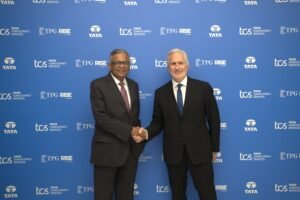Greater Noida (Hridaya Mohan): Forty-one years after Wing Commander Rakesh Sharma etched his name into history as the first Indian in space, the nation has once again touched the stars. In a moment of triumph that blends national pride with cutting-edge science, India has successfully launched its first astronaut in over four decades—this time aboard a homegrown spacecraft as part of the ambitious Gaganyaan mission.
This is not just a journey from Earth to orbit. It is a journey from memory to mission, from dependence to self-reliance and from symbolic participation to strategic leadership in human spaceflight.
Watch Falcon 9 launch Dragon and @Axiom_Space‘s Ax-4 mission to the @Space_Station https://t.co/OJYRpM5JCF
— SpaceX (@SpaceX) June 25, 2025
From Soviet Soyuz to Swadeshi Spacecraft
Back in 1984, Rakesh Sharma floated in zero gravity aboard a Soviet capsule Soyuz T-11 with the aspirations of a nation still finding its footing in space. His famous words—“Saare Jahan Se Achha”—were more than a poetic tribute; they were a promise that India would one day carve its own path among the stars. Today, that promise has been gloriously fulfilled. With the successful launch of Gaganyaan, India has not just repeated history—it has rewritten it. The Gaganyaan astronaut represents a wholly Indian achievement: trained under Indian systems, carried by an Indian rocket and supported by Indian mission control. This is a landmark step in Atmanirbhar Bharat—self-reliant India—not just in slogan but in scientific capability.

A Journey from Vision to Reality
From the humble beginnings of the Thumba Equatorial Rocket Launching Station in 1963 to the triumphant roar of Gaganyaan’s engines, India’s space saga has been one of perseverance and ingenuity.
This mission is more than a technological marvel—it is a validation of India’s homegrown capabilities. Unlike Sharma’s flight, which relied on foreign collaboration, Gaganyaan is a testament to indigenous innovation. The crew module, life-support systems and cutting-edge escape mechanisms were all designed and tested on Indian soil, proving that our scientists can conquer challenges once thought insurmountable.
India becomes the fourth country in the world, after the US, Russia and China, to independently send a human into space. ISRO, once doubted as an extravagant dream in a developing nation, has now joined the elite club—and shows that India’s space journey is not just about satellite launches and planetary probes, but also about the human spirit of exploration.
Why This Matters
Skeptics often question the value of sending humans to space in an age of advanced robotics. But human spaceflight carries a symbolism and soft power unmatched by machines. It demonstrates trust in national capability. It inspires generations. It places a country on the strategic map not just of science, but of diplomacy, defense and global collaboration.
The timing could not be better. As nations race to set up stations on the Moon, send missions to Mars and even plan space-based infrastructure, India now has the credibility to be part of these high-level ventures. Human spaceflight is not just a frontier—it’s a foothold.
The Success Resonates Beyond Space
Critics may still ask: Why spend on space when earthly problems persist? But Gaganyaan’s triumph answers that emphatically. The mission has already spurred advancements in medicine, materials engineering and artificial intelligence—technologies that will trickle down to healthcare, disaster management and national security. Moreover, it cements India’s position in the booming global space economy, ensuring we are not just consumers but leaders in the next frontier.

New Horizons for a New Generation
Gaganyaan has reignited a sense of national pride and scientific curiosity. The four astronauts-designates—now on the brink of making history—are not just pilots but symbols of what India can achieve when ambition meets execution. Their journey will inspire millions of young minds to look up and dream bigger.
For India’s youth, this mission signals more than just a news headline. It lights a spark. With the success of Chandrayaan-3 and now Gaganyaan’s crewed launch, students across India are being invited to dream bigger—of becoming astronauts, astrophysicists, engineers or mission directors.
It also boosts India’s growing private space sector, as startups and companies align with ISRO to build components, payloads and next-gen systems. Human spaceflight, in that sense, is not a single event—it’s an economic and technological multiplier.
From Orbit to the Moon and Beyond
With Gaganyaan’s success, the next steps are even more exhilarating. ISRO’s plans for a sustained human spaceflight program, a space station by 2035 and an Indian landing on the Moon are no longer science fiction—they are inevitable milestones. International collaborations will accelerate, but the foundation is now unmistakably Swadeshi.
According to ISRO astronaut, Shubhanshu Shukla, “This is not the start of my journey but the start of India’s human space programme.”
As we celebrate this giant leap, let us remember that Gaganyaan is not the end—it is the beginning. Four decades ago, India hitched a ride to space. Today, we have built our own vehicle. The stars are no longer out of reach; they are our next destination.
A Tryst Rekindled
Nehru once spoke of a “tryst with destiny.” In space, we had ours briefly in 1984. Now, after 41 long years, India has returned—not as a guest, but as a full participant.
As the Gaganyaan astronaut looked down on Earth, perhaps the words of Rakesh Sharma echoed again. But this time, it’s not just a memory—it’s a mission renewed.
Jai Hind! Jai Vigyan! Jai Antariksh!!
About the Author

Mr. Hridaya Mohan (hridayamohan@yahoo.co.in) is a regular Columnist with a renowned Indian daily “The Hitavada”, “Bharat Neeti Media” and some other newspapers / magazines internationally. Superannuated as Executive Director, Steel Authority of India Ltd. (SAIL), he is Senior Adviser, Metallon Holdings Pvt. Ltd. presently. He headed SAIL office at Beijing as Chief Representative (China & Mongolia) for six years. He has published and presented seventeen papers globally. Recipient of “Sir M Visvesvaraya Gold Medal”for one of his papers, “Benchmarking of Maintenance Practices in Steel Industry” from The Institution of Engineers (India), he was awarded with “Scroll of Honour” for the excellent contributions to Engineering fraternity from IE(I), Bhilai, “Jawahar Award” for leadership excellence in SAIL and “Supply Chain Leader – 2017” award from IIMM.









